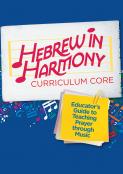- Home
- Play & Learn Home
- Online Enrichment
- Experience Modern Israel
- Israel It's Complicated
- Jewish and Me
- Jewish Holidays Jewish Values
- Jewish Values in Genesis and Jewish Values in Exodus
- Min Ha’aretz
- Our Place in the Universe
- Simply Seder
- The Prophets: Speaking Out for Justice
- Making T'filah Meaningful
- Make, Create, Celebrate
- Yom Haatzmaut Resources
- Hebrew Apps
- About The OLC
- What is the OLC?
- Introduction
- Get Started
- Resources
- OLC Content
- Parent Materials
- See My OLC Classes
- Store
Engage Emotions to Help Learning
Written by Behrman House Staff, 05 of July, 2016
Good teachers know that meaningful, long-lasting learning happens when students feel invested in the content. Something happens on an emotional level that resonates with students, making what they're learning feel relevant to their lives.
“It is neurobiologically impossible to think deeply about things that you don’t care about,” according to neuroscientist Mary Helen Immordino-Yang in a recent New York Times piece drawing from her book, “Emotions, Learning, and the Brain." This student connection can actually be seen on brain scans in real time.
“When students are emotionally engaged,” she writes, “we see activations all around the cortex, in regions involved in cognition, memory and meaning-making, and even all the way down into the brain stem.”
We are embracing this research and infusing it into much of our work and thinking as we seek to help teachers build connections with students on deeper emotional and spiritual levels. For example, we know that music evokes emotion, which in turn boosts morale and motivation and leads to more durable retention. Our new prayer curriculum for 4th-6th graders, Hebrew in Harmony, is rooted in music precisely because of its power to spark interest and engage students with the content.
Emotional connection can happen in many ways, whether via music and creative arts or simply by making content relevant to students' personal interests. While tuned-in teachers can do this with all kinds of abstract concepts or ideas, tapping into emotion is also particularly useful in fostering meaningful learning around Jewish values.
Our approach to values education uses the lenses of holidays and the Bible to provide context for critical thinking. We tie these values to students by drawing connections to their lives. For example, in Jewish Holidays, Jewish Values Journal, Hanukkah provides the backdrop for the concept of courage, Gevurah. Students examine different ways of showing courage in today's world, such as saying no to peer pressure or confronting a bully, and reflect on how they can might act in certain situations.
In Jewish Values in Exodus, students use the story of Moses at the Burning Bush to explore the value of leadership, Manhigut. They discuss what it means to be a leader, how leadership is important for a community, and consider different ways they can take on leadership in their own lives, such as participating in student council or being nice to a student who is being teased or ignored.Our Living Jewish Values series gives students tools to explore 16 core values from thought-provoking and novel perspectives that are relevant to their own lives. For example, in a lesson about personal satisfaction, Sameach B'chelko, students decide whether a cell phone or concert tickets is a need or a want, and explore what it means to be content. A personality quiz helps them identify what makes them most happy.
As you take stock of what worked well and not so well this year, and begin planning for fall, remember these words of advice from Dr. Immordino-Yang: "The most important thing educators can do with children ... is to develop relationships with them and really get to know them. Find ways that you can engage with and meet them where they are, so that they can make their way into the complex maze of educational experiences that will open up doors for them."




